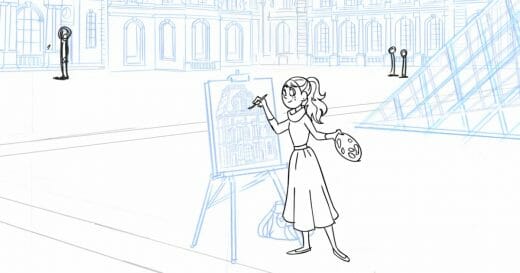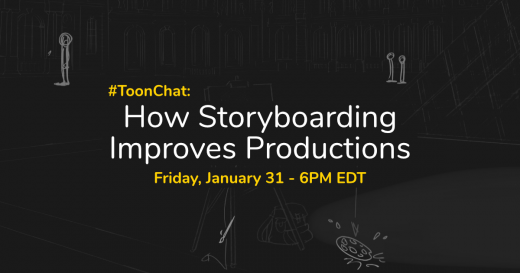
What do you get when you put the mind of a criminal mastermind inside the body of a young protagonist? The answer is Bulletproof Candy. Created by Ghostbot co-founder and veteran animator Alan Lau, Bulletproof Candy is an epic, character-driven sci-fi romance that blurs the lines between comics and animation. With more than 2,000 cinematic panels, a gripping screenplay, and a dynamic teaser brought to life in Toon Boom Harmony, this project showcases the power of storytelling across mediums.
Alan’s experience includes directing for studios like Disney, Marvel, and Netflix, which helped shape Bulletproof Candy into a polished, emotional narrative. From fluid character animation and a clear visual language that blends hand-drawn and vector assets with stylish 2DFX, Alan shares a glimpse at the tools and techniques that went into the trailer.
Watch the teaser below and read the full article to learn how Bulletproof Candy proves that with the right tools and vision, indie creators can create their own studio-quality projects.
Please introduce yourself and your background in animation and some of the studios you’ve worked with.
Alan: I began my career as a traditional animator, working with studios like W!ldbrain, Curious Pictures, Mondo, Leapfrog, and Madhouse. In 2004, I co-founded Ghostbot Animation, where I’ve had the opportunity to lead creative projects for major clients, including Disney, Marvel, Lucasfilm, Pixar, Netflix, and Sony.
Over the years, I’ve taken on roles in creative development, direction, storyboarding, and animation, while also focusing on client collaboration, team leadership, and mentorship. My experience spans a wide range of styles in both 2D and 3D animation across games, film, and digital media.
Can you provide a brief synopsis of Bulletproof Candy and what readers should expect to see in the webcomic?
Alan: In a future ruled by the ruthless mega-corporation OPEN WORLD, a young woman, Mae takes a deadly job to save her people: smuggle data implanted in her brain through the Hellway, a savage wasteland. But she doesn’t know the truth: the data will kill her.
To ensure the data’s delivery, a mysterious warrior named Greta is assigned to drive Mae through the Hellway. As they fight to survive the dangerous journey, an unexpected romantic bond begins to form between them. But the data inside Mae isn’t just information: It’s Nova, the mind of a dead criminal mastermind plotting resurrection and revenge against OPEN WORLD.
As his thoughts begin to bleed into Mae’s, she starts to lose control. And Greta? She’s not just protecting Mae. She was sent by Nova to ensure his return. Now she’s torn between obeying a dead man and saving the woman she’s falling for.
Bulletproof Candy is about fighting for what you believe in. It’s about defying corruption, embracing your identity, and proving that kindness and empathy can change even the hardest of hearts.

Can you walk us through your process for designing a comic page with cinematic sensibility in mind?
Alan: I always envisioned Bulletproof Candy as an animated movie and wanted the comic reading experience to be as close to that as possible. I brought on the amazing Mae Catt (The Legend of Vox Machina) to write the script using a traditional three-act movie structure. As a result, the comic flows with the pacing and rhythm of a feature film.
Instead of using a traditional comic layout, I produced the entire 2000+ panel webcomic using a consistent 1920×1080 format for each image. While this uniformity has pros and cons, it makes it easier to adapt the comic into other forms of media. One of my goals is to share the comic across many different platforms, so it can be enjoyed by a wide audience.
What are the unique challenges of creating an original piece of work like Bulletproof Candy?
Alan: There were so many challenges! Ha ha!
Creatively, one of the biggest challenges was balancing my personal quality standards with the sheer volume of work. With so many panels in the comic, I had to prioritize what mattered most: character and story.
The timeframe was a big challenge as it took many years to complete the project. One thing that helped was shifting my workflow. I usually animate at a traditional computer workstation, but for this comic, I used Procreate on my iPad. That simple change let me draw more casually on the couch, on the go, and during downtime. It made the process more enjoyable and sustainable in the long run.

How did you strike the balance between 2D traditional animation and 3D environments to maintain the comic’s unique style?
Alan: For the comic, there was very little 3D that was utilized. For future comic projects, I would love to use 3D for vehicles, backgrounds, and layout to streamline production. For the animated teaser, it was an opportunity to bring the characters to life and to show the potential of how they could exist in animation. I wanted to have the 2D characters leap out of frame and felt the 3D environments we created supported that.
What key skills or learnings did you work for animation studios provide you that has helped you create the original series?
Alan: Great question. Running an animation studio has made me deeply aware of every facet of production. In that environment, you’re constantly looking for ways to deliver the best work as efficiently as possible. That mindset was invaluable during the creation of the series. It helped me stay focused, resourceful, and intentional with every step.

How do you decide which software to use for different parts of the process, and where does Harmony fit into the workflow?
Alan: I’m always excited to explore new software. I believe continuous learning is key to artistic growth. For the animated teaser, I used Procreate for the storyboards and animated the main characters in Toon Boom Harmony, Roman Laney (art director) built the 3D environment in Blender and handled compositing in After Effects. The original score was composed by Gabriel Hays, and I completed the final mix in Premiere.
You mentioned Bulletproof Candy was never just a comic. How do you envision this teaser turning into a wider animated project in the future?
Alan: My dream is to turn Bulletproof Candy into an animated feature. But animation is expensive, so I asked myself: how can I share this epic character-driven romance in a way that’s accessible to audiences now? Starting with a comic felt like the perfect answer. We could create and finish the entire story this way. It’s an affordable proving ground to show its future potential.
Now that it’s complete, I plan to share the comic across more webcomic platforms as well as YouTube and TikTok to build a fanbase around the adventures of Mae and Greta. With a finished movie script, finished comic, and a growing fanbase, the chances of Bulletproof Candy evolving into animation through crowdfunding or traditional media channels become much more possible.

How has creating this teaser expanded your personal creative development, and are there new techniques or tools using Harmony you’re excited to explore next?
Alan: I’m a big fan of Harmony! For future comic and animation projects, I’d love to take advantage of its 2D puppet rigging system to streamline some of the more repetitive artistic tasks. I’m certainly interested in exploring the possibility of creating an entire comic in Harmony, as its vector brushes offer a range of styles that translate beautifully to comic form.
For artists seeking to turn comics into animation, what advice would you give based on your journey with Bulletproof Candy?
Alan: Now is a great time to create original IP. While studios often stick to familiar franchises, there’s a growing audience hungry for fresh, unique, and niche stories. Don’t wait for permission! Thanks to accessible tools like Harmony, Adobe, Procreate, and Blender, it’s never been easier to produce your own content. The creative possibilities are wide open.
If you’re thinking about translating comics into animation, remember they’re fundamentally different mediums. Comics require more visual detail, while animation requires simplification to maintain fluid motion. Understanding the strengths and limitations of each pipeline is crucial.
Creating a comic is no small task. It sharpens all of your artistic skills, including character design, backgrounds, storyboarding, layouts, props, and directing. Animation is a tremendous amount of work, which often requires a team to complete. Think carefully about what idea or story you want to convey before diving in. My advice: Start small. Do a short test comic or animation before diving into a larger project. It’ll give you valuable insights without overwhelming your bandwidth.
- Want to see more of Bulletproof Candy? Read the webcomic series for free on Tapas and visit Ghostbot’s website to learn more.
- Interested in animating a trailer for your webcomic? Artists can download a 21-day trial of Toon Boom Harmony.



